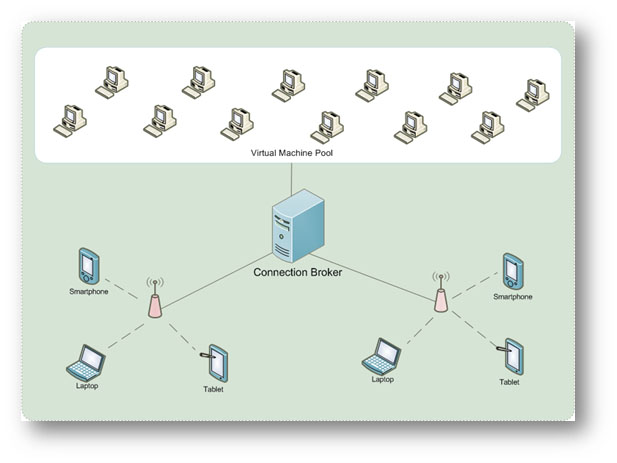Bring Your Own Device (BYOD) in Learning: An Update
The Computing Services Centre (CSC) is preparing to launch the Virtual Desktop Service (VDS) program very soon, to cater for the trend of Bring Your Own Device (BYOD) and explore the feasibility of adopting personal mobile devices for teaching and learning. Around 40 virtual desktops will be provided in the first phase. Users can connect to the virtual desktops using their mobile devices such as tablets and notebook computers via the campus wireless LAN.

- Only general purpose (no Graphics Process Unit) virtual desktops are provided in the first phase
It is too expensive to support graphics intensive programs such as Photoshop and AutoCAD that require Graphics Process Unit (GPU) to run, but this will be studied in our next phase. - Multiple versions of large applications cannot be supported in a single image
To minimize the installation time of large applications, some selected large applications will be pre-installed in the image of the virtual desktop. Once the application is installed, other versions of the same application cannot be added. For example, other versions of Microsoft SQL Server such as version 2005 or 2008 cannot be installed if Microsoft SQL Server 2014 is already installed in the image.
For more information on the challenges that the VDS present, please refer to the article on “Cater for the Trend of Bring Your Own Device (BYOD) in Teaching” ( the VDS, please refer to the article on “Cater for the Trend of Bring Your Own Device (BYOD) in Teaching” (Ref: Network Computing Issue 81 – September 2014).
Next Phase
All-Flash Storage Array – an all-flash array is a solid state storage disk system that contains multiple flash memory drives instead of spinning hard disk drives. Data can be transferred to and from solid state drives (SSDs) much faster than hard disk drives. The performance of the VDS can be greatly improved if all-flash storage array is used for the shared storage of the virtual desktop infrastructure, thus providing better speed and user experience. This will be essential when expanding the VDS support.Web-Scale – web-scale means the system is able to handle rapid growth efficiently and not have bottlenecks that require re-architecting at critical moments. As the virtual desktops are hosted on the central server, additional virtual desktops can be created easily to better accommodate teaching and learning demands. The flexibility in the expansion and speed of virtual desktop provisioning and the maximum size of the virtual desktop pool that can be supported are the important factors of a virtual desktop solution.Convergence – convergence allows multiple tasks to be performed on a compact device. Space and power can be effectively conserved in a highly converged system. It is especially important for the potential large scale deployment of the VDS.